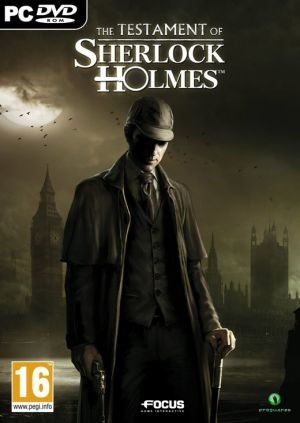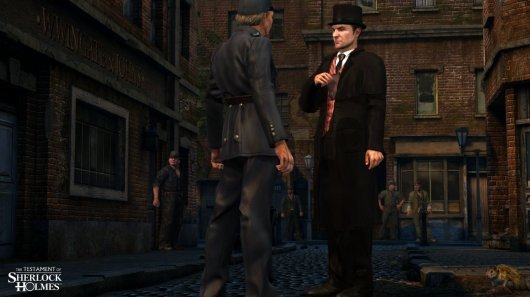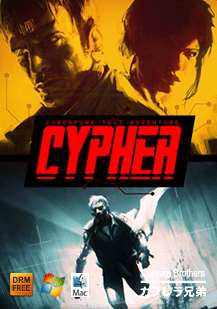Review for The Testament of Sherlock Holmes

It’s fair to say old Sherlock Holmes is enjoying a well-deserved renaissance in popularity lately, from the Guy Ritchie/Robert Downey Jr. movies to the TV shows Sherlock and Elementary. But few current adaptations want to take Holmes back to his Victorian detective roots; they either want to modernize him or, dare I say it, make an action hero out of him. Enter Frogwares, long the purveyors of Sherlock Holmes adventure games, to once again give us a slice of good old fashioned British sleuthing. It's hard to believe they've been at this nearly a decade, but the experience is clearly paying off. In The Testament of Sherlock Holmes, the seventh game in the series and the first to be designed for cross-platform release, Frogwares delivers their best adventure so far, and arguably the greatest Sherlock Holmes game ever made.
This latest investigation is full of references to not only Conan Doyle's Holmsian universe but also to the developer's established canon of games, largely based on their own invented stories. I’m sure everyone has their favourite (personally I loved The Awakened) but Testament feels like the game Frogwares have been building to for a long time. There’s a maturity to the gorgeous presentation, puzzle design and interface accessibility that can only have come by learning from their previous games.
Testament undoubtedly involves the series’ most intriguing plot yet, and a lot of work has gone into making it fit together. Eschewing the darkness and violence that has been a prominent feature in recent titles, this is instead a well-lit game with few corpses. There are still some grisly crime scenes and uncomfortable subject matter to be found here, rendered in vivid detail, but on the whole this is a far brighter affair. The “darkness” of the game’s tag line (“His darkest adventure yet”) comes from the psychology at play as Watson struggles to understand the motives behind his long-time friend's disturbing behaviour.
The last three games have relied on a ‘crossover’ hook (Cthulhu mythos, Arsène Lupin and Jack the Ripper) but in this instalment it’s all about Sherlock, and from the title alone you’ll know he has a lot to answer for. Unusually, the story kicks off at the end of an investigation. Holmes and Watson have just solved the case of the Marquess of Conyngham’s missing Samoan necklace, only to find the trinket to be a cheap fake. Upon returning to Baker Street, Sherlock is astonished to find the newspapers are pointing the finger squarely at him as the culprit for the switcheroo. Cannily knowing there’s more to this sudden slander than meets the eye, Holmes and Watson endeavour to clear his name by following leads that take them on an adventure all across London.
But is Holmes really innocent? As with previous games, the story is narrated from Watson’s point of view, meaning we’re not party to all of Sherlock's movements. You’ll control both Holmes and Watson in this game, but if at any point Holmes is called away from Watson’s side then it is Watson we stay with – inevitably leading to something horrific happening ‘off camera’ with Holmes looking like the guilty party. Before long, even Watson doubts his old friend after Holmes is attached to an increasingly violent string on incidents. The intrigue mounts throughout the game as you try to piece together the clues that will reveal the truth behind his seemingly criminal actions.
A few loose plot threads aside, the story works brilliantly. Although not formally divided, the game plays out in three acts: the introduction, where Holmes and Watson investigate the circumstances surrounding the fake necklace, the chase after the evidence becomes overwhelmingly stacked against Sherlock, and finally the confrontation when all is revealed. However, with so many twists and turns as the plot progresses, I couldn’t possibly go into further detail. Suffice it to say that Frogwares have been playing a long game with us, and there are plot threads dating back to The Awakened for the keen eye to spot. No knowledge of the previous games is required as everything is explained here, but series fans will be well rewarded for their attention to detail. There are even some returning characters like Lucy from Jack the Ripper and good old Inspector Lestrade.
As well as a brave new story, Testament also sees a radical overhaul of Frogwares' game engine, which includes new motion and facial animations as well as high definition background graphics, three distinct control methods to suit different playing styles and a much more user-friendly approach to puzzle solving. The whole package feels like a much slicker operation than their previous instalments, and the graphics are the crowning glory. It’s rare to find a fully 3D adventure game these days, especially one that looks this good. The locations you visit are all beautifully crafted down to the minutest detail; a particular highlight occurs early on at the Bishop of Knightsbridge’s house, a small cottage in a leafy suburb where shadows playing off the side of the house and vivid garden colours give a real sense of beauty to the scene.
The streets of London are also bustling with life to add to the vibrant backdrops. You’ll visit various locations around the city, from a dank prison to grimy Whitechapel, where there’s a real buzz in particular. It’s possible to interact with background characters, but there are no lengthy dialogue chains, merely one sentence interactions like “Alms for the poor.” When you do engage in conversations, a wheel appears at the bottom of the screen with the dialogue options available. Anyone who has played either Mass Effect or Dragon Age 2 will be familiar with this mechanism, and it's clearly designed for console players, though it works just as well on PC. Regardless of platform, however, it can be a little unclear what Sherlock will ask once a word is selected.
The character animation is a marked step up from previous games; people will sway and look around more naturally, and there are more dynamic facial expressions during conversations. It’s still not perfect, as the lip movements don’t sync with the words being spoken. Similarly, character movements can feel a little light, like floating down steps with little connection between the feet and the ground. Yet by adventure game standards, this is probably the slickest presentation we’ve seen since L.A. Noire or Portal 2.
The default perspective is a third-person viewpoint: here the player moves Sherlock and Watson with the WASD keys (or left gamepad analog stick) and moves the camera with the mouse (or right stick). An optional point-and-click interface fixes the camera to locked positions while the mouse is used for movement and interaction. Alternatively, a first-person direct control option works in much the same way as third-person, but seen directly through the protagonist's eyes. These schemes can be quickly cycled through and each comes with its own pros and cons.
I stuck mainly with the third-person direct control mode, as this makes hotspots appear when Holmes approaches them, whereas point-and-click requires you to sweep the scene looking for things to interact with, which can get tiresome in some of the more sprawling locations. I sometimes needed to switch between a couple of different modes as the locked-off point-and-click camera revealed parts of a scene I missed when using the others. Everyone has their own playing style, however, so it’s nice that Frogwares recognises this and has catered for various needs.
Watson offers his own brand advice in the form of glib interjections and oddly intonated exclamations, but he isn't always so helpful. Some locations are small, and Watson sometimes blocks doorways or gets in the way, causing Holmes to continuously walk on the spot as he tries to pass him. However, because the good doctor narrates the story he still feels integral to the game, and it wouldn’t be a Sherlock Homes adventure without him. The gameplay doesn’t change when you control Watson; you’ll just experience the scene from another point of view. A particularly good use for this is at an abandoned watermill, where the actions you perform as Watson affect Sherlock in another part of the building. You’ll also control Toby, Sherlock’s faithful mutt from the book The Sign the Four, for a sequence where Toby must follow the scent of a suspect through a warehouse. It’s an adorable little interlude and a good example of how Frogwares are able to spice up the action to stop it feeling samey.
As in previous instalments, the puzzles are principally split into two categories: deduction puzzles and logic puzzles. Deduction puzzles are based on the clues you find and the solutions you come up with on the “deduction board”. These are story-related and help progress the narrative. The logic puzzles are usually encountered as locks on doors, chests and secret passages, as well as various forensic investigations. Both are staples of the Sherlock franchise, but Testament is more forgiving than its predecessors, allowing for a more relaxed approach whilst still satisfying those with a masochistic bent. For example, no deductions can fail so you can’t set a foot wrong in the investigation, but you’ll want to sit and think each clue through or else you’ll end up doing an awful lot of trial-and-error guesswork. Similarly, you can skip any logic puzzle after a few minutes so you’ll never find yourself unable to progress.
The deduction puzzles are the most enjoyable. The deduction board from Jack the Ripper makes a welcome return, and when you click on items Holmes will give his thoughts before either adding a note to the board or moving on. Once enough notes have been gathered on the board, it’s then up to the player to work through them all in the style of a flow chart to make the correct connections. You’ll start with information you’ve gathered and as you move along the chart you’ll make multiple-choice decisions until the story fits together. Clues can come in all shapes and sizes, from muddy footprints to cigar butts and even character testimonials, a few being quite hard to spot in their natural environments. Thankfully, Sherlock has his trusty sixth sense for just such an occasion, so by simply pressing space bar the available hotspots will flash briefly to alert you to anything you may have missed.
The logic puzzles are for those who like it rough. Most players will be thankful for the skip option at some point, as these challenges adhere closely to the fiendishly difficult mantra of older Sherlock games. They’re mostly used as bizarre locks on various boxes or doors and range from fairly simple push-the-ball-bearing-down-the-hole types to cruel move-the-knight-to-the-last-possible-position-on-a-chess-board ones. One particularly evil sequence has you solving four math puzzles in a row, each bearing no relation to the previous one. These puzzles feel rather arbitrarily shoehorned in to extend the length of the game, but I know a lot of people live for this type of conundrum without concern for integration, and they’ll be pleased to know that Frogwares haven’t held back.
Unfortunately, for all the notable tweaks and improvements, the sound is still a bit of a letdown. The same few classical tracks are played on repeat in the background, regardless of dramatic effect. They suit the tone of the period (pianos and strings) but are often misplaced and can jar with the action on screen. The voiceovers are passable; most are well acted but Watson is still prone to some odd intonation and there’s a clunky framing device featuring three children in an attic who really needed better voice work. Similarly, whilst the script is fairly good, there are still a few odd lines: for example, Holmes states, “This shovel belongs to the cemetery workers,” only for Watson to reply with, “You frighten me Holmes.” There’s nothing game-breaking here, but it does fall short of an otherwise stellar package.
The game is fairly lengthy, taking around 15 hours to finish, and by the end of the game all the pieces have fallen into place for a truly monumental finale. It’s bound to cause some controversy, which is not to say it’s bad, but it does have elements that will divide fans. I personally thought it was a satisfying ending, but it might frustrate fans of the Conan Doyle books. But love it or hate it, as the arty Tarantino-esque credit sequence rolls and you can finally sit back and soak in what you’ve seen, you will surely be wondering where Frogwares will go from here.
The Testament of Sherlock Holmes is exactly that: a testament to the care and attention Frogwares have paid to the Sherlock Holmes name for nearly ten years. It’s the culmination of the developer's own growth as well as feedback from critics and fans alike, and is sure to impress both in bucketloads. From the sumptuous locations to the intriguing plot, from the comfortably familiar characters to the multiple control schemes to suit any preference, the game ticks all the boxes for a truly first-class package. Add to that the more accessible puzzle approach and you've got an appealing package for old and new fans alike. Sherlock Holmes may never have behaved this badly before, but it’s possibly his finest hour.






























